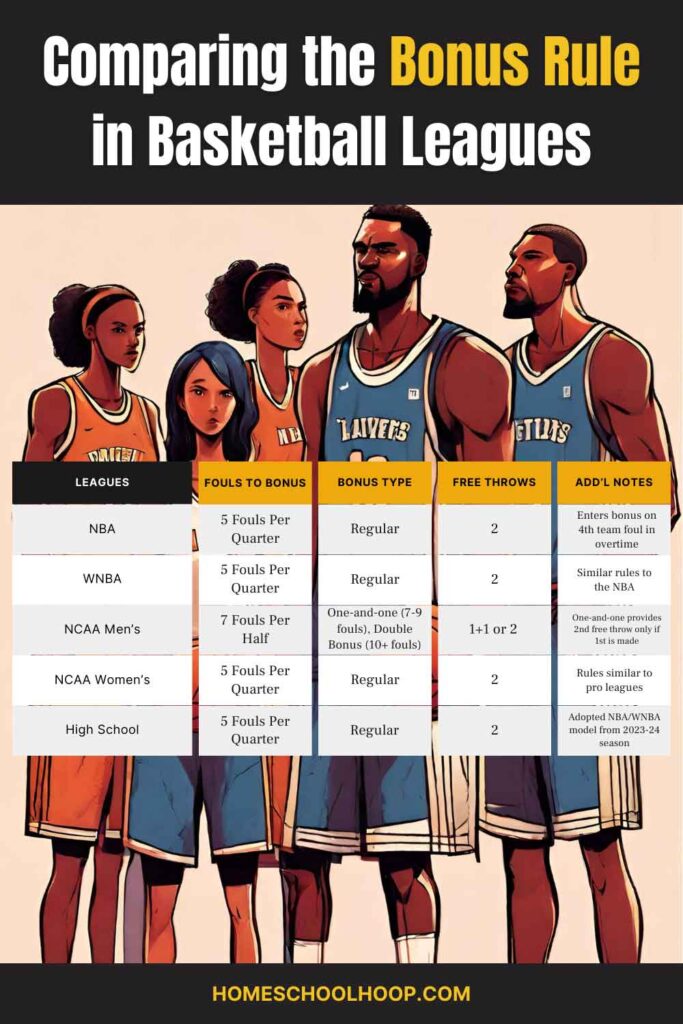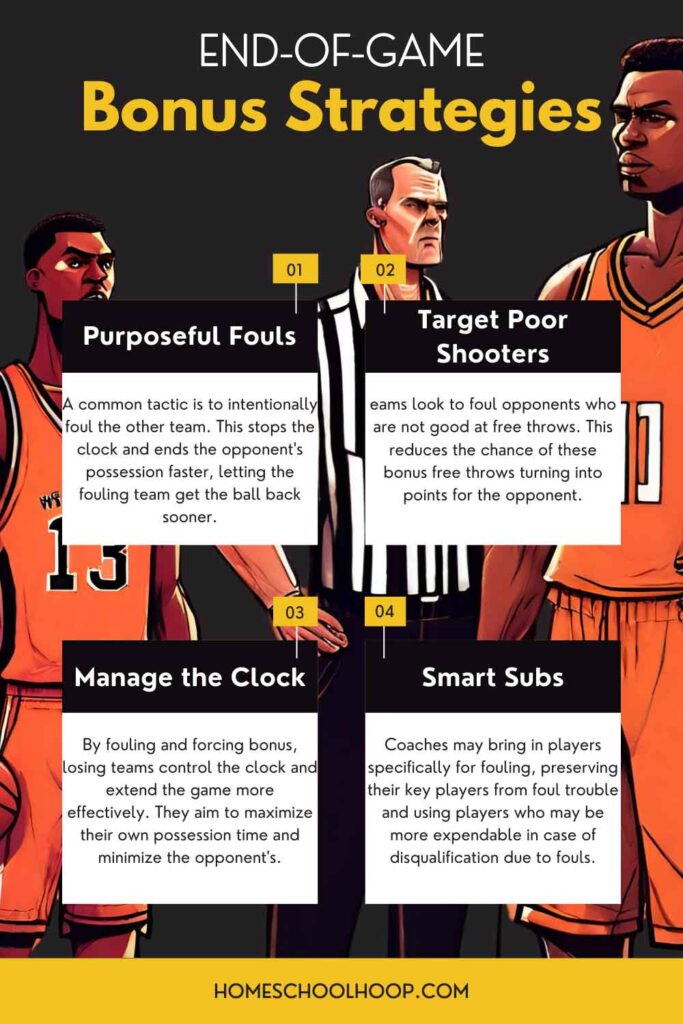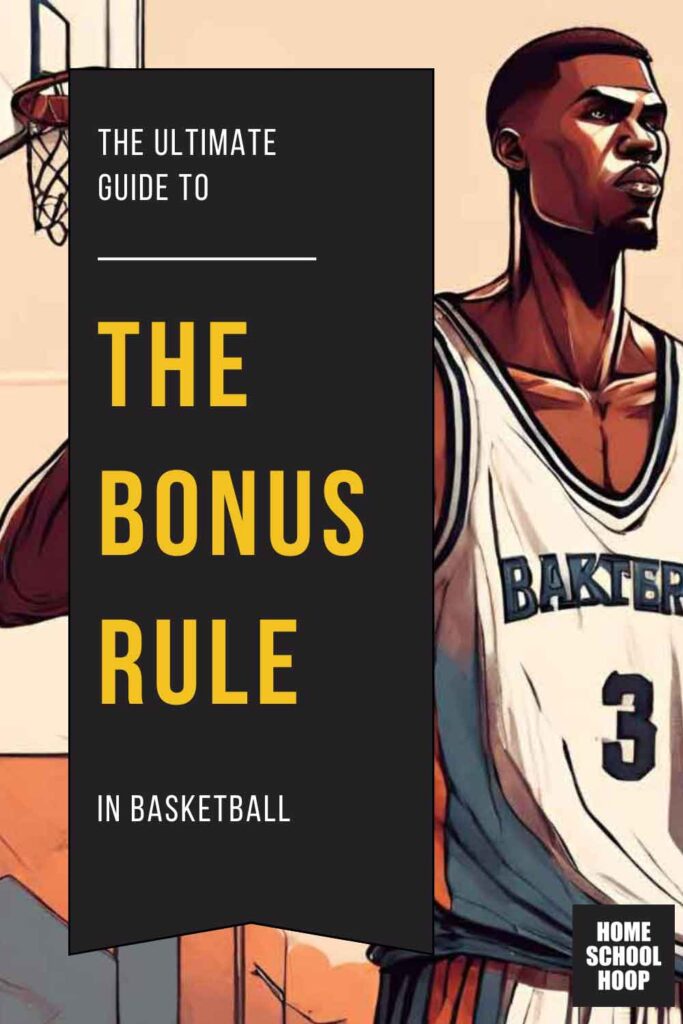This article was originally published on December 7, 2023, and then updated on April 26 to reflect the latest information.
The basketball bonus rule can play a huge role in a game’s outcome, and yet it’s often misunderstood. Here’s what you need to know:
Key takeaways:
- The bonus rule in basketball gives a team free throws if the opposing team commits a certain number of fouls in a period.
- Bonus is meant to stop teams from committing too many intentional fouls and to keep the game moving.
- Basketball bonus becomes especially important in the last few minutes of a game, when foul management and points from free throws can determine the winner.
The bonus rule is not at all new. It’s been a part of basketball since 1891, just a year after the game was invented. But there’s no arguing that it’s a much bigger part of the game today.
The specifics of the rule do vary slightly between basketball leagues, from professional games in the NBA and WNBA to high school basketball.
If you’re just looking for an overview, here we’ll cover the basics of the bonus in basketball. But we’ll also dive into the nuances of the rule, and explore how teams can use it in their strategy to pull out close games.
What is Bonus in Basketball?
Simply put, the “basketball bonus” rule triggers when a team commits a certain number of fouls during a period, triggering a penalty phase called the bonus.
How it works:
- Reaching the Bonus: When a team commits a certain number of fouls (usually five or seven) in a quarter or half, the opposing team is said to be “in the bonus.” Keep in mind that the number of team fouls resets to zero after each period.
- Free Throws: Being in the bonus means that every time the team is fouled moving forward, they get to take free throws. Even if the foul wasn’t committed during a shot, they still get to try for points from the free-throw line.
Bonus can become a critical part of the game. For example:
The team in the bonus can use the rule to their advantage. By drawing fouls through being more aggressive and driving to the basket, they get more free-throw opportunities to score more points.
The fouling team needs to be cautious because committing too many fouls can give the opponent easy chances to score from free throws. On the other hand, if they’re losing, the bonus rule can become advantageous. They might foul on purpose to stop the clock and get the ball back more quickly, hoping the other team misses their free throws.
How Bonus Varies in Different Basketball Leagues
The bonus rule in basketball isn’t the same everywhere. Different leagues have their own versions. Let’s look at how each of the leagues handles this rule:
Table 1. Bonus Rules Across Different Basketball Leagues
| LEAGUE | FOULS TO BONUS | BONUS TYPE | FREE THROWS | ADD’L NOTES |
| NBA | 5 Fouls Per Quarter | Regular | 2 | Enters bonus on 4th team foul in overtime |
| WNBA | 5 Fouls Per Quarter | Regular | 2 | Enters bonus on 4th team foul in overtime |
| NCAA Men’s | 7 Fouls Per Half | One-and-one (7-9 fouls), Double bonus (10+ fouls) | 1+1 or 2 | One-and-one provides 2nd free throw only if 1st is made |
| NCAA Women’s | 5 Fouls Per Quarter | Regular | 2 | Rules similar to pro leagues |
| High School | 5 Fouls Per Quarter | Regular | 2 | Adopted NBA/WNBA model from 2023-24 season |

NBA Bonus Rules
In the NBA, teams enter the bonus on the fifth team foul in each quarter or if they commit two fouls within the last two minutes of the quarter, whichever comes first. In overtime, teams enter the bonus on the fourth team foul.
Once they reach the bonus, the opposing NBA team gets two free throws (one free throw attempt plus a penalty free throw attempt) for each foul.
Learn more: How long are NBA games?
WNBA Bonus Rules
The WNBA follows similar rules to the NBA. A team enters the bonus on the fifth foul of a quarter or two fouls in the last two minutes of each quarter. The team in the bonus gets two free throws for each foul.
Learn more: How long are WNBA games?
FIBA Bonus Rules
In FIBA (international basketball), the bonus rule starts on the fifth foul of each quarter. Unlike the NBA and WNBA, there’s no additional rule for fouls in the last two minutes. Teams get two free throws for each foul after the fifth.
If games go into overtime periods, team fouls accrue from the fourth period on and trigger a bonus on the fifth foul, rather than reset.
NCAA: Unique Approach to the Bonus Rule
The NCAA’s bonus rule differs for men’s and women’s games.
In men’s NCAA basketball, which plays two 20-minute halves rather than quarters, the bonus starts on the seventh team foul. This leads to a one-and-one free throw chance. If the first throw is made, there’s a second attempt. Ten fouls bring in the double bonus, giving two free throws for every foul.
In women’s NCAA basketball, played in quarters, teams enter the bonus and get two free throws starting from the fifth foul in each quarter. In overtime, the fouls from the fourth quarter carry over.
High School Bonus Rule
Starting in the 2023-24 season, high school basketball is adopting the NBA/WNBA model. The bonus begins on the fifth foul per quarter, allowing two free throws. Previously, high schools used a one-and-one bonus for the seventh foul and two free throws for the tenth foul in each half.
What is a Flagrant Foul in Basketball? A Beginner’s Comprehensive Guide
Mastering the Back Screen in Basketball
What Makes a Triple-Double in Basketball So Special? Inside Look with Examples
Implications of the Bonus in Basketball
The basketball bonus rule changes how teams play, especially as the game nears its end. It brings a layer of strategy for both offense and defense, letting teams use the bonus rule to their advantage.
Offensive Tactics to Use Bonus to Score
- Aggressive Play: When in the bonus or close to it, teams might play more assertively, like driving to the basket or posting hard, to draw fouls. Drawing a foul leads to free throw chances.
- Substitute In Better Free Throw Shooters: Coaches often make sure their best free throw shooters are on the floor when they’re in the bonus. This increases their chances of scoring from free throws.
Defensive Strategies to Avoid Bonus Penalties
- Cautious Defense: To avoid putting their opponent in the bonus and giving away free throws, teams might play less aggressive defense. They focus on positioning and footwork instead of physical contact, and give up easy layups rather than risk getting called for a foul.
- Smart Player Rotation: Coaches might substitute players who are less prone to fouling to reduce the risk of putting the other team in the bonus.
End-of-Game Bonus Strategies
Putting an opponent in the bonus isn’t always a bad thing. Sometimes, it can be a deliberate tactic, especially when a team is behind and the game is almost over. Here’s how:
- Purposeful Fouling: A common tactic is to intentionally foul the other team. This stops the clock and ends the opponent’s possession faster, letting the fouling team get the ball back sooner.
- Targeting Poor Free Throw Shooters: Teams look to foul opponents who are not good at free throws. This reduces the chance of these bonus free throws turning into points for the opponent.
- Managing the Game Clock: By fouling and forcing bonus, losing teams control the clock and extend the game more effectively. They aim to maximize their own possession time and minimize the opponent’s.
- Strategic Substitutions: Coaches may bring in players specifically for fouling, preserving their key players from foul trouble and using players who may be more expendable in case of disqualification due to fouls.

This approach is a gamble. It relies on the opposing team missing free throws and the fouling team scoring quickly on their subsequent possessions.
Hack-a-Shaq Strategy
The ‘Hack-a-Shaq’ strategy is an example of trailing teams using the bonus in basketball to try to come back in games.
Named after Shaquille O’Neal, the tactic involves intentionally fouling a poor free-throw shooter who is otherwise hard to defend. It’s a way to try and limit the opponent’s scoring by sending a player with low free throw accuracy to the line, hoping they will miss.
When the opposing team is in the bonus, fouling a weak free throw shooter who otherwise would easily score field goals can be advantageous. This foul strategy is a calculated risk, trading potential free throw points for what might be a more certain two or three points.
Find out: What Shaquille O’Neal had to say about his free throw woes and other Shaq quotes.
Understanding Team Fouls and the Bonus
When it comes to understanding the basketball bonus situation, it’s crucial to know about team fouls. This knowledge can change how you view the game.
Bonus in basketball is triggered by a team hitting a particular team foul count. Team fouls are the total number of personal fouls (defensive fouls and loose ball fouls) committed by players on a team. Offensive fouls do not count toward the team foul total.
So, every time a player commits a personal foul for things like hand-checking, pushing, or blocking, it adds to their total team fouls.
Once a team reaches a certain number of team fouls (which varies by league), the opposing team enters the bonus situation. And in the bonus, any foul committed by the team, except for offensive fouls (like charges), results in free throws for the other team.
Bonus vs. Double Bonus in College Basketball
NCAA men’s basketball is unique in that it has both bonus and double bonus situations. These rules decide if a player gets a one-and-one free throw chance or two guaranteed free throws.
One-and-One Bonus
In NCAA men’s basketball, when a team commits seven fouls in a half, the opposing team gets a one-and-one bonus. In this case, the fouled player gets one free throw. If they make it, they earn a second free throw. If they miss, the ball is live, and play continues.
Double Bonus
The double bonus starts with the tenth team foul in a half. Unlike the one-and-one, the double bonus gives the fouled player a guaranteed two free throw attempts regardless of the outcome of the first shot.
In NCAA men’s basketball, these one-and-one and double bonus situations add an interesting twist. In contrast, NCAA women’s basketball, the NBA, WNBA, FIBA, and high school basketball offer two automatic free throws for each bonus situation.
FAQs
What does bonus mean in basketball?
In basketball, ‘bonus’ refers to a situation where a team gets to shoot free throws every time the opposing team commits a foul. This happens after the opposing team reaches a certain number of fouls in a game period.
Does high school basketball have bonus?
Yes, high school basketball has a bonus rule. Starting from the 2023-24 season, the bonus starts on the fifth team foul per quarter, with two free-throw opportunities for each foul.
How does bonus work in the NBA?
In the NBA, the bonus situation occurs when a team commits five fouls in a quarter. After reaching five fouls, every subsequent foul results in two free throws for the opposing team.
Why was the double bonus rule introduced in college basketball?
The double bonus rule in NCAA men’s basketball discourages excessive fouling. It ensures that after a team commits ten fouls in a half, the opposing team gets two guaranteed free throws, penalizing teams more severely for frequent fouling.
Can a team be in bonus in every quarter/half?
Yes, a team can be in the bonus in every quarter or half if the opposing team reaches the foul limit in each period. This is common in games with aggressive defense or physical games.
How does the bonus affect game strategy?
Basketball bonus affects game strategy in several ways. Offensively, teams might play more aggressively to draw fouls and earn free throws. Defensively, teams try to avoid fouling to prevent easy scoring opportunities. It also influences clock management, player substitutions, and overall game tempo.






***commit two fouls in the last two minutes.
This is wrong:
In the NBA, teams enter the bonus on the fifth team foul in each quarter or if they commit a foul within the last two minutes of the quarter, whichever comes first. In overtime, teams enter the bonus on the fourth team foul.